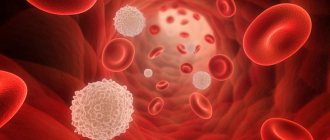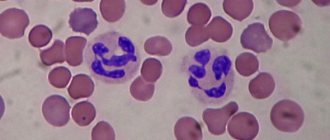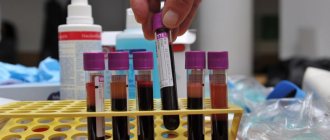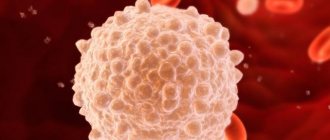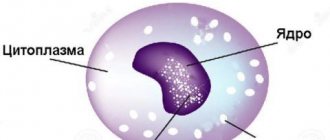Leukocytes in the blood of the human body occupy an honorable place as a protector.
These are the cells that always know where the immune defense weakens and the disease begins to develop. The name of these blood cells is leukocytes. In fact, this is a generalized name for a conglomerate of specific cells that protect the body from the adverse effects of all types of foreign microorganisms. Their normal level ensures the full functioning of the organs and tissues of the body. When the level of cells fluctuates, various disturbances in its functioning occur, or in other words, fluctuations in the level of leukocytes characterize the occurrence of a problem in the body.
What are leukocytes
Leukocytes are large blood elements in the form of balls that have no color.
It is commonly believed that leukocytes are white blood cells, but in reality this is not entirely true.
If you look at them under a microscope, you can see that they are actually pink-purple. For reference. The content of leukocytes in the blood is less than that of red blood cells.
White cells are the product of red bone marrow. White cells of various types circulate in the human body, differing in their structure, origin, and functions. But they are all the most important cells of the immune system and solve one main task - protecting the body from external and internal enemy microorganisms.
White cells are able to actively move not only through the circulatory system, but also penetrate through the walls of blood vessels and infiltrate tissues and organs. Constantly monitoring the situation in the body, when danger is detected (the appearance of foreign agents), leukocytes quickly find themselves in the right place, first moving through the blood, and then moving independently with the help of pseudopods.
Having detected a threat, they capture and digest foreign bodies. When a large number of foreign bodies penetrate into the tissue, white cells, absorbing them, greatly increase in size and die. This releases substances that cause an inflammatory reaction. It can manifest itself as swelling and increased temperature.
Functions of white blood cells
The process of destroying foreign bodies is called phagocytosis, and the cells that carry it out are called phagocytes. Leukocytes not only destroy foreign agents, but also cleanse the body. They utilize unnecessary elements - the remains of pathogenic microbes and destroyed white bodies.
Another function of blood cells is the synthesis of antibodies to destroy pathogenic elements (pathogenic microbes). Antibodies can make a person immune to some diseases that he has previously suffered.
Also, leukocytes influence metabolic processes and supply tissues with necessary hormones, enzymes, and other substances.
Life cycle
Protecting the body, a large number of white cells die.
To maintain their level close to normal, that is, in the required quantity, they are constantly produced in the spleen, bone marrow, lymph nodes and tonsils. The life cycle of Taurus is on average 12 days. Substances released during the destruction of white cells attract other leukocytes to the site of penetration of enemy microorganisms. By destroying these bodies, as well as other damaged cells of the body, white blood cells die in large quantities.
The purulent masses present in the inflamed tissues are accumulations of dead white cells.
Norm of leukocytes in the blood
The norm of leukocytes in the blood in the analysis results is indicated in absolute values. Blood cell levels are measured in units per liter of blood.
For reference. It should be noted that the content of white cells in the blood is not a constant value, but can vary depending on the state of the body and the time of day. However, in healthy adults these changes do not deviate greatly from the norm.
The concentration of bodies usually increases slightly in the following cases:
- after meals;
- By the evening;
- after active physical labor or mental stress.
For reference. The normal level of white cells in humans is 4-9 x109/l. Considering the total volume of blood in the human body, we can say that there are from 20 to 45 billion lymphocytes.
Normal white cell count:
- In men, the normal value of the indicator is 4.4-10x109/l. In the male body, the number of white cells is less subject to fluctuations than in other groups of people.
- In women, this indicator is more variable; the standard value is 3.3-10x109/l. The level of this indicator may vary depending on menstruation and hormonal levels.
- For pregnant women, a value of up to 12-15 x109/l should not cause concern, since such a value is considered normal for a given physiological state. The increased level of the indicator is explained by the reaction of the mother's immune system to the presence of the fetus. With a higher level of corpuscles, the woman’s condition must be closely monitored, due to the high risk of premature birth.
- The norm for children depends on their age category.
Action of leukocytes
White blood cells perform many important functions to ensure human health. The properties of leukocytes allow them to move to any organs and tissues. When a harmful microorganism is detected, leukocyte cells move to the site of inflammation through the bloodstream. Then they move independently using pseudopods to the bacteria or virus that needs to be neutralized. The specific structure and functions of leukocyte cells provide them with the ability to act in any situation. Leukocytes work as long as they live, approximately 12-15 days.
White blood cells perform the following tasks:
- The main function of white blood cells is protective. Constantly moving through the bloodstream, they represent a kind of “patrol” that monitors the appearance of intruders - harmful viruses or bacteria.
- Once detected, the pathogen is identified and white blood cells produce antibodies to fight it. If a disease is discovered that a person has already had, specific antibodies are produced that are necessary to resist this particular disease.
- Phagocytosis is of great importance for the immune system. Cells - phagocytes are capable of absorbing destroyed viruses and affected cells of the patient's body. Leukocytes in the blood also absorb toxic waste products of harmful agents.
- Some types of white blood cells destroy pathogens at the cost of their own lives. The destroyed cells are absorbed by other white blood cells.
- The regenerative role of leukocytes is to heal damaged tissues and cells.
Diseases do not always show obvious symptoms. Some diseases and viruses begin to develop in a latent form, and malaise manifests itself at the advanced stage of the disease. People may not even realize that they are already sick, while white blood cells provide resistance to the disease from the moment of infection. Once white blood cells detect the presence of an infection, parasite, virus or other disease, the body begins to produce large numbers of new white blood cells to fight the disease.
This process is reflected in the analysis results.
Based on the data obtained, the attending physician makes a diagnosis and prescribes appropriate treatment. That is why blood leukocytes are considered human protectors.
Increased white blood cell count
A condition in which the number of leukocytes is more than 9 thousand per 1 ml of blood is called leukocytosis.
You need to understand that elevated white blood cells in the blood are a relative phenomenon. When performing a general blood test, it is necessary to take into account the patient’s gender, age, nutritional pattern and a number of other indicators.
In general, leukocytosis indicates an existing inflammatory process in the body. The reasons for the increase in the level of corpuscles can be physiological and pathological.
Causes of leukocytosis
A physiological increase in white blood cell levels does not require treatment. It can occur in the following cases:
- hard physical labor;
- after meals (after meals the indicator can reach 12 x109/l);
- nutritional characteristics (the body may perceive some components of meat products as foreign antibodies);
- pregnancy period, childbirth;
- taking contrast baths;
- after administration of the vaccine;
- period before menstruation.
If the level of non-physiological white cells is elevated, it is necessary to conduct a general examination or another blood test 3-5 days after the first one to exclude errors. If the white blood cell count does not decrease, then there is still a problem.
When physiological causes are excluded, elevated white blood cells indicate the presence of one or more of the following causes:
- bacterial infectious diseases (tonsillitis, meningitis, pneumonia, pyelonephritis, etc.);
- viral infections (mononucleosis, chickenpox, viral hepatitis);
- various inflammatory processes (peritonitis, abscess, appendicitis, infected wounds);
- blood diseases (leukemia, anemia);
- myocardial infarction;
- tumor diseases;
- carbon monoxide poisoning;
- extensive burns;
- after taking certain medications.
Types of leukocytes
A blood sample contains mature and immature cells. Neutrophils are the most numerous group in the total number of white blood cells. Segmented neutrophils—mature cells—circulate in the blood. The body's reserves contain a large number of band neutrophils, immature cells that mature when viruses or bacteria penetrate. The infected cell is marked as "dangerous", which it is. Neutrophils absorb and process foreign cells, microorganisms and particles of affected cells using their own enzymes. Each neutrophil is capable of neutralizing more than 20 bacteria, but performing this function can lead to cell death.
Lymphocytes are the second largest group of white blood cells. The process of destruction of foreign cells carried out by lymphocytes also affects the destruction of cancer cells. It is lymphocytes that can show that the development of neoplasms is beginning. These cells live for more than 20 years, circulate through the blood and penetrate the tissues of the body. Some lymphocytes are responsible for recognizing foreign agents, while another part produces the necessary antibodies to fight them.
Monocytes are sent to the site of infection after neutrophils. They show the greatest activity in an acidic environment. Each monocyte is capable of absorbing and neutralizing hundreds of harmful agents. They also absorb destroyed neutrophils and damaged cells of inflamed tissue.
In addition to their protective functions, monocytes regulate the process of hematopoiesis and have a beneficial effect on the dissolution of blood clots.
Eosinophils are a fairly small group of white blood cells. Their main action is aimed at destroying and neutralizing the toxic effects of decay products of pathogenic microorganisms on the body. Eosinophils are responsible for developing immunity against parasites. The enzymes they produce penetrate the tissues and cell membranes of parasites and their eggs.
Basophils in the blood are contained in very small quantities (less than 1%), but they contain important biologically active substances. Their number increases significantly with leukemia, acute inflammatory processes and severe stress. A slight increase in the level of basophils is observed in chronic inflammation and various allergic reactions.
Should leukocytes be raised or lowered?
Patients are often interested in how to lower or increase leukocytes in the blood if their level deviates from the norm. There are many ways to do this, some of which are useless, and some of which are simply dangerous to health.
Important! An increase or decrease in the level of corpuscles does not require urgent reduction to a normal value. A thorough examination of the patient and identification of the cause of the change in the indicator is necessary . If the causes of the deviation are successfully eliminated (treated), the level of white cells will return to normal.
Leukocyte formula
For leukocytes, like other blood cells, there is a certain norm that is observed in a healthy body. Deviations from the norm indicate possible health problems and the development of diseases. The total number of white blood cells has a certain numerical value of the content of leukocytes per liter of blood or per 1 mm3. The norm for adults is 4–9 × 109/l, 4–9 billion/l or 4000-9000 per 1 mm3. As a result of the analysis, white blood cells may be designated WBC.
An advanced blood test called a leukogram determines the percentage of different types of white blood cells in relation to the total number. The result obtained is the leukocyte formula. This test is done to determine which types of white blood cells are high or low. The normal leukocyte formula for an adult is as follows:
| Neutrophils | 50–75% |
| Lymphocytes | 18–40% |
| Monocytes | 2–10% |
| Eosinophils | 1–5% |
| Basophils | less than 1% |
Using these data, the attending physician can determine a possible threat to the patient’s health. Thus, a high level of eosinophils means an allergy or damage to the body by parasites. Based on the leukogram data and clinical symptoms, appropriate additional examination is prescribed to confirm the diagnosis.
Why is the level of red blood cells in a blood test important?
If there are few red blood cells, they will not be able to efficiently deliver oxygen. Fewer red blood cells - less hemoglobin - less iron ions that can bind and deliver oxygen.
Organs that do not receive enough oxygen will work worse. Naturally, this will immediately affect your well-being; oxygen starvation of organs and tissues will occur.
Over the course of life, the number of red blood cells changes. On average, men have more of them than women - 3.9–5.5⋅1012 per liter versus 3.9–4.7⋅1012 per liter. In newborns there are up to 6⋅1012 red blood cells per liter, in older people - up to 4⋅1012 per liter.
If there are fewer red blood cells in the blood, the doctor may diagnose “anemia” (in common parlance – anemia). This does not mean that there is less blood in the body than needed - it is the number of red blood cells in each liter of this fluid that causes concern.
Generally speaking, anemia is not a disease, but a symptom. She talks about disruption of the body. The doctor’s task is to understand the cause and help the patient cope with the problem.
Most often, anemia occurs after significant blood loss. It is common in pregnant women, as well as in children and the elderly.
It happens that the number of red blood cells is normal, but there is not enough hemoglobin in them. In the analysis, this is manifested by a change in the color of red blood cells, therefore the color index (CI) is also indicated in the results. It reflects the color of the red blood cell, normally the value should be between 0.86 and 1.1. But there are also normochromic anemias - just when there are few red blood cells, but there is enough hemoglobin in each of them.
On the other hand, there may be more red blood cells than usual. Erythrocytosis occurs with the development of neoplasms, polycythemia, vitamin deficiency, Cushing's syndrome or hydrocele of the renal pelvis, respiratory and heart failure. Also, the level of red blood cells increases due to treatment with steroids and corticosteroids.
However, the level of red blood cells may increase due to dehydration - after a hard workout, with a high fever, vomiting or diarrhea. But for pilots, flight attendants and residents of high mountainous areas, elevated levels of red blood cells are common. This is how the body copes with the lack of oxygen at altitude.
So, balance is important. The body must have enough red blood cells, and each of them must have a normal amount of hemoglobin.
Possible reasons for the increase and decrease in red blood cells
A slight deviation from the norm will rarely be the result of a specific pathological process. This condition can be caused by dietary errors, stress, or a long-term illness that weakens the immune system.
A significant decrease in red cells in the blood can be a consequence of the following pathological processes:
- deficiency or poor absorption of vitamin B12;
- Iron-deficiency anemia;
- excessive amount of fluid consumed;
- acute or chronic blood loss.
An increase in the number of red blood cells may be due to the following provocateurs:
- diseases of the cardiovascular system;
- dehydration of the body;
- staying at high altitude for a long time;
- disruption of the process of formation of bodies due to oncological processes;
- lung diseases;
- smoking;
- insufficient amount of oxygen in tissues.
Only a doctor can determine the cause of a particular pathological process. If you feel unwell, you should seek medical help rather than carry out treatment at your own discretion. Red blood cells in the body must be contained in optimal quantities.
Source: MedAnaliz.pro
Normal in blood
It should be understood that the total number of red blood cells in women or men by age and the norm in the circulatory system are not the same thing.
The total number includes three types of red blood cells:
- those still developing in the bone marrow;
- those that will soon leave the bone marrow;
- those that already travel through the blood system.
Red blood cells in the blood of women are contained in smaller quantities, which is due to the loss of a certain amount of blood during the menstrual cycle. The normal content of red blood cells in the blood of women is 3.9–4.9 × 10^12/l.
The normal rate of red blood cells in men is 4.5–5×10^12/l. Higher rates are due to the production of male sex hormones, which produce their synthesis.
In children, red cells should normally be contained in the following quantities:
- in newborns - 4.3-7.6 × 10^12/l;
- in a two-month-old baby - 2.7–4.9 × 10^12/l;
- by year - 3.6–4.9×10^12/l;
- in the period from 6 to 12 years - 4–.5.2 × 10^12/l.
During adolescence, red blood cell counts are compared with adult norms. More specific figures by age will be provided by a table that can be found on the Internet.

